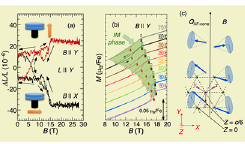Novel Magnetoelectric Phase in Multiferroic BiFeO3
Tokunaga Group
Simultaneous emergence of multiple “ferroic” orders, such as (anti)ferromagnetism, ferroelectricity, and ferroelasticity, brought about fruitful physics caused by non-trivial coupling among various degrees of freedom in condensed matters. Among numerous multiferroic materials, BiFeO3 is perhaps the most extensively studied because of its huge spontaneous electric polarization (PS) as well as high ferroelectric and antiferromagnetic ordering temperatures. Our recent careful studies of magnetoelectric effects in high-quality crystals of BiFeO3 revealed existence of novel electric polarization (PT) normal to the PS that can be controlled by magnetic and electric fields in a non-volatile way [1, 2]. These findings clarified that BiFeO3 will be useful for non-volatile memory devices writable by electric fields, readable simply by measuring their resistance, and stable against external magnetic fields at least up to 4 T.

Fig. 1. (a) Magnetostriction of BiFeO3 single crystal at 300 K measured with using the capacitance method. The insets show schematics of the capacitance cell and applied magnetic field. (b) Isothermal magnetization curves at various temperatures between 150 K and 310 K. We observed anomaly in the shaded area and assigned it as the intermediate phase. (c) Proposed spin order in the intermediate phase. This conical antiferromagnetic state can be regarded as a superposition of the cycloidal state in the YZ plane and the canted antiferromagnetic state within the XY plane.
Emergence of PT suggests breaking of the three-fold rotational symmetry around PS. Although this kind of distortion was proposed by earlier experimental studies using a synchrotron x-ray radiation facility [3], relation between magnetic order and lattice distortion has been veiled. We studied magnetostriction of a single crystal of BiFeO3 with using a renewed capacitance dilatometer in pulsed magnetic fields up to 55 T (Fig. 1(a)). The results clearly resolved existence of slight (1/50,000) lattice deformation, which can be controlled by applied magnetic fields in irreversible way indicating ferroelastic nature of this material [4].
In addition to the irreversible behavior below 10 T, we observed non-monotonic change in magnetostriction between 10-15 T that suggests emergence of an intermediate phase between cycloidal and canted-antiferromagnetic phases. This feature of the intermediate phase is also observed in measurements of isothermal magnetization and electric polarization [4]. The intermediate phase grows up with increasing temperature as shown by shaded area in Fig. 1(b). According to a model calculation based on the standard Hamiltonian for this material, conical antiferromagnetic order as illustrated in Fig. 1(c) can be stabilized at a certain parameter space. Field induced transition from the cycloidal to this conical phase is expected to rotate the spin modulation vector from X to Y direction in Fig. 1(c). Our neutron experiment revealed that incommensurate spin modulation along the X-direction in the cycloidal state becomes commensurate in the intermediate phase, which is consistent with our expectation. The magnetoelectric effects in this intermediate phase is considerably larger than those in the other phases. Our findings will open novel possibility in this well-known material.
References
- [1] M. Tokunaga et al., Nat. Commun. 6, 5878 (2015).
- [2] S. Kawachi et al., Appl. Phys. Lett. 108, 162903 (2016).
- [3] I. Sosnowska et al., J. Phys. Soc. Jpn. 81, 044604 (2012).
- [4] S. Kawachi et al., Phys. Rev. Mater. 1, 024408 (2017).
